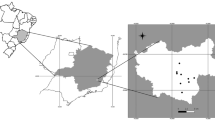Abstract
We screened fecal samples from 3 groups of wild-living baboons (Papio cynocephalus and P. anubis), involved in longitudinal behavioral studies, for evidence of gastrointestinal parasites. The two objectives of the study were: 1) to compare parasites from two of the groups with different foraging behavior from the same area and 2) to obtain fecal parasitic data on 3 groups of baboons to provide baseline reference data. We sampled individual baboons opportunistically from Lodge and Hook's groups, Amboseli National Park and from Mpala Group, Mpala Wildlife Research Centre, Kenya. Lodge Group baboons supplemented foraging on wild foods by daily foraging in human-source refuse, whereas Hook's and Mpala groups did not. We collected fecal samples from 55, 30 and 42 individuals in Hook's, Lodge and Mpala groups, respectively, and processed them via ether sedimentation. We identified strongylids, Streptopharagus sp., Physaloptera sp., Trichuris sp., Enterobius sp., and Strongyloides sp., in the feces, but no parasite directly attributable to exposure to people. Garbage- and wild-feeding Amboseli baboons differed in the prevalence of Streptopharagus sp., Physaloptera sp. and Trichuris sp.
Similar content being viewed by others
References
Alberts, S. C., and Altmann, J. (2001). Immigration and hybridization patterns of yellow and anubis baboons in and around Amboseli, Kenya. Am. J. Primatol. 53: 139-154.
Alexander, K. A., and Appel, M. J. G. (1994). African Wild Dogs (Lycaon pictus) endangered by a canine distemper epizootic among domestic dogs near the Masai Mara National Reserve, Kenya. J. Wildl. Dis. 30: 481-485
Altmann, J., and Muruthi, P. (1988). Differences in daily life between semiprovisioned and wild-feeding baboons. Am. J. Primatol. 15: 213-221.
Altmann, J., Schoeller, D., Altmann, S. A., Muruthi, P., and Sapolsky, R. M. (1993). Body size and fatness of free-living baboons reflect food availability and activity levels. Am. J. Primatol. 30: 149-161.
Ashford, R. W., Reid, G. D. F., and Butynski, T. M. (1990). The intestinal faunas of man and mountain gorillas in a shared habitat. Ann. Trop. Med. Parasitol. 84: 337-340.
Eley, R. M., Strum, S. C., Muchemi, G., and Reid, G. D. F. (1989). Nutrition, body condition, activity patterns and parasitism of free-ranging baboons (Papio anubis) in Kenya. Am. J. Primatol. 18: 209-219
Flynn, R. J. (1973). Parasites of Laboratory Animals, Iowa State University Press, 884pp
Kemnitz, J. W., Sapolsky, R. M., Altmann, J., Muruthi, P. M., Mott, G. E., and Stefanick, M. L. (2002). Effects of food availability on serum insulin and lipid concentrations in free-ranging baboons. Am. J. Primatol. 57: 13-19
Kuntz, R. E., and Meyers, B. J. (1966). Parasites of baboons (Papio doguera [Pucheran, 1856]) captured in Kenya and Tanzania, East Africa. Primates 7: 27-32
Kuntz, R. E., and Moore, J. A. (1973). Commensals and parasites of African baboons (Papio cynocephalus L. 1766.) captured in Rift Valley Province of central Kenya. J. Med. Primatol. 2: 236-241
Meade, B. J. (1983). Host–Parasite Dynamics Among Amboseli Baboons, PhD Dissertation, Virginia Polytechnic Institute and State University, Blacksburg, VA, 200pp
Muchemi, G. M. (1992). Baboons as a Maintenance Host of Human Schistosomiasis in Kenya, Dissertation, University of Liverpool, England
Müller-Graf, C. D., Collins, D. A., Packer, C., and Woolhouse, M. E. (1997). Schistosoma mansion infection in a natural population of olive baboons (Papio cynocephalus anubis) in Gombe Stream National Park, Tanzania. Parasitology 15: 621-627
Munene, E., Otsyula, M., Mbaabu, D. A. N., Mutahi, W. T., Muriuki, S. M. K., Muchemi, G. M. (1998). Helminth and protozoan gastrointestinal tract parasites in captive and wild-trapped African non-human primates. Vet. Parasitol. 78: 195-201.
Muruthi, P. M. (1990). Food Intake and Energy Expenditure Among Savannah Baboons, MSc Thesis, University of Nairobi.
Muruthi, P. M. (1997). Sociological Correlates of Parental Care and Demography in Savannah Baboons, Dissertation, Princeton University, 34pp
Muruthi, P. M., Altmann, J., and Altmann, S. (1991). Resource base, parity, and reproductive condition affect female's feeding time and nutrient intake within and between groups of a baboon population. Oecologia 87: 467-472.
Owen, D. G. (1992). Parasites of Laboratory Animals, Laboratory handbooks No. 12, Laboratory Animal Ltd by Royal Society of Medicine Services, London
Pereira, M. E. (1988). Effects of Age and Sex on Intra-Group Spacing Behavior in Juvenile Savannah Baboons Papio-Cynocephalus-cynocephalus. Anim. Behav. 36: 184-204
Phillips-Conroy, J. E., Hildebolt, C. F., Altmann, J., Jolly, C. J., and Muruthi, P. (1993). Periodontal health in free-ranging baboons of Ethiopia and Kenya. Am. J. Phys. Anthropol. 90: 359-371.
Richie, L. S. (1948). An ether sedimentation technique for routine stool examination. Bull. US Army Med. Dep. 8: 326.
Rolland, R. M., Hausfater, G., Marshall, B., and Levy, S. (1985). Antibiotic-resistant bacteria in wild primates: Increase prevalence in baboons feeding on human refuse. Appl. Environ. Microbiol. 49: 791-794.
Sapolsky, R. M., and Else, J. G. (1987). Bovine tuberculosis in a wild baboon population: Epidemiological aspects. J. Med. Primatol. 16: 229-235.
Stuart, M., Pendergast, V., Rumfelt, S., Pierberg, S., Greenspan, L., Glander, K., and Clarke, M. (1998). Parasites of wild howlers (Alouatta spp.). Int. J. Primatol. 19: 493-512.
Tarara, R., Suleman, M. A., Sapolsky, R., Wabomba, M. J., and Else, J. G. (1985). Tuberculosis in wild olive baboons, Papio cynocephalus anubis (Lesson), in Kenya. J. Wildl. Dis. 21: 137-140.
Author information
Authors and Affiliations
Rights and permissions
About this article
Cite this article
Hahn, N.E., Proulx, D., Muruthi, P.M. et al. Gastrointestinal Parasites in Free-Ranging Kenyan Baboons (Papio cynocephalus and P. anubis). International Journal of Primatology 24, 271–279 (2003). https://doi.org/10.1023/A:1023092915171
Issue Date:
DOI: https://doi.org/10.1023/A:1023092915171




